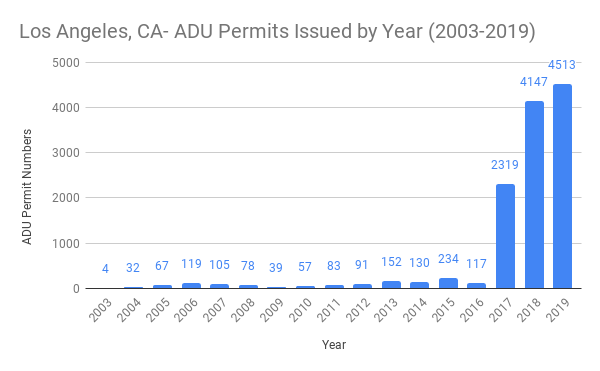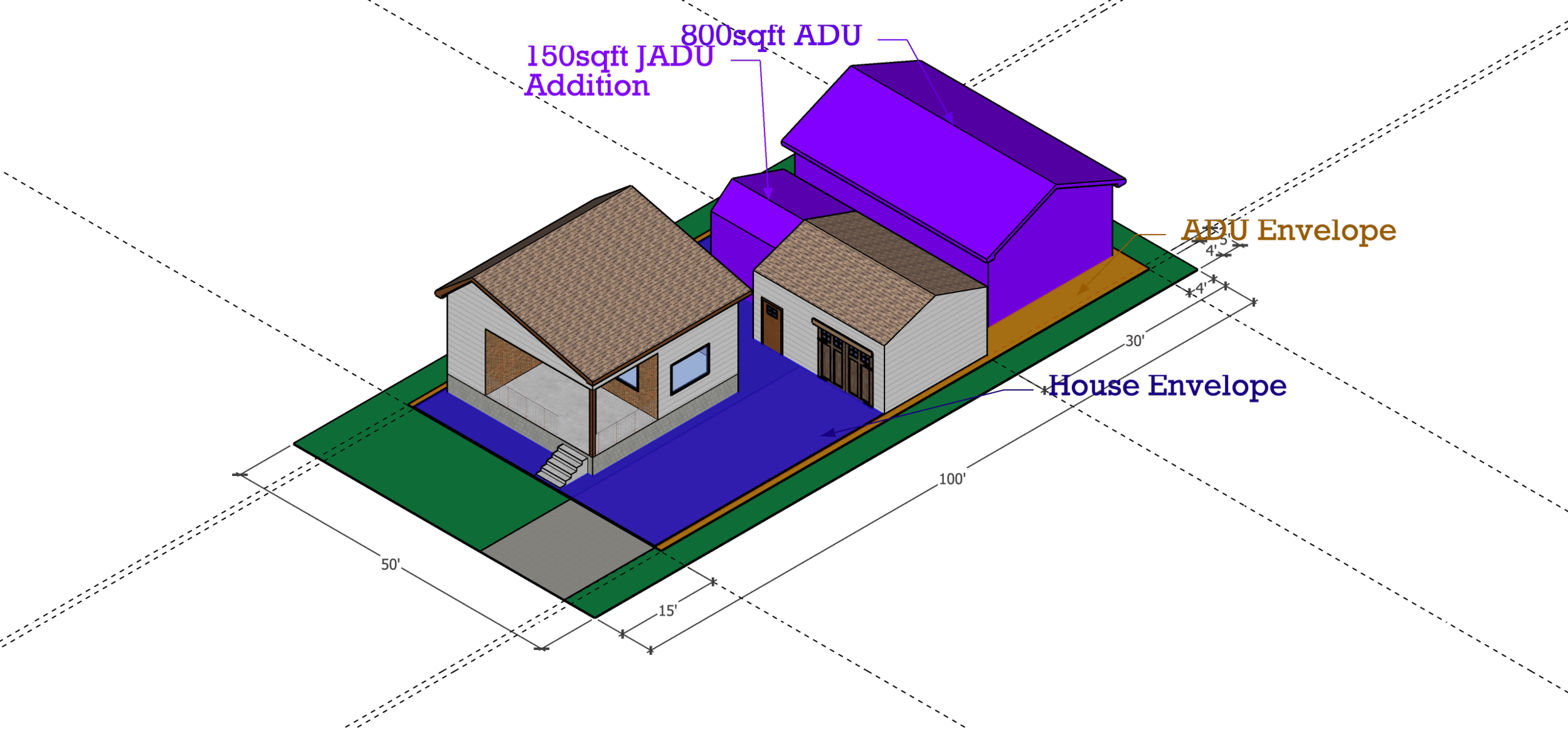Back in June, 2017, Los Angeles burst onto the ADU scene a record-breaking number of ADUs in the first quarter of that year. It was the beginning of an explosion of ADUs in Los Angeles, and one that foreshadows the next era of ADU development in America.
Note: 2019 is projected based on the current permits issued so far this year (Oct, 2019)
There are now more than 12,000 ADU permits issued by the City of Los Angeles total. This is an astonishingly large number of ADU permits, relative to all other jurisdictions not just nationally, but globally.
Of course, L.A. is the 2nd largest US City with a population of 4 million people. By contrast, the City of Portland has roughly 650,000 people. So, the number of ADUs per capita is still extraordinarily low in Los Angeles, as well as in all other US cities.
The average number of ADU permits issued from 2003-2016 leading up to California’s 2017 ADU legislation was 95 permits/year. In dramatic contrast, the projected number of ADUs permits that will be issued in 2019 is 4,513 permits/year.
As an observer and ADU advocate who bemoans the pathetically low development numbers of ADUs in US cities, this type of 47-fold increase is astonishing.
And just as astonishingly, the regulatory changes that occurred in L.A which spurred this growth consisted primarily of only two seemingly minor things:
1) An elimination of off-street parking requirements
2) A reduction in rear and side yard setbacks.
These changes to the code in L.A. were prompted by state legislation which superseded local codes that had dramatically suppressed the natural ADU development rate.
Los Angeles is now the largest market of ADUs anywhere in the US. And, it’s still a very new market for ADUs.
Where L.A. goes, so goes….California?
Last week, Governor Newsom signed into state law a suite of housing bills, including five ADU bills (AB 68, AB 881, AB 587, SB 13, and AB 671).
For Californian homeowners, this suite of bills is a game-changer. Here are the four most significant changes in my opinion in bold, though there are MANY changes that will be of benefit to those who wish to build an ADU.
1) SB 13 eliminates owner occupancy requirements statewide.
One reason why ADUs have taken off already in Los Angeles is because they do not have owner occupancy requirements, whereas most jurisdictions in CA currently have these restrictive ordinances in place.
2) All CA cities must reduce side and rear yard setbacks to no more than 4’.
Los Angeles adopted statewide setback rules in 2017, but other cities which had their own ADU setback standards weren’t impacted. AB 68 and 881 changes that. Let’s take San Francisco, as an example. Their current onerous detached ADU regulation stipulates:
“…in almost no case will you be allowed to build an addition or new structure in the last 25% (or 15’ at minimum) of your property (for example, if your lot is 100’ deep, the rear setback would be 25’ from the rear property line), dependent on zoning.”
Let’s be clear: A 25’ setback requirement entirely kills any detached ADU potential.
Under the new CA state laws, this setback goes from 25’ to 4’. Wow! Suddenly, rear yard setbacks in a major city like San Francisco are no longer a barrier to ADU development.
3) An elimination of residential impact fees for any ADUs that are 750 sq ft or less.
This fee elimination is what prompted the ADU explosion in Portland beginning in 2010.
4) Homeowners can build two ADUs on any residential property.
One detached ADU and one “Junior ADU”, which is a type of structural conversion ADU.
A visual depiction of two ADUs on a property from https://carlaef.org/adus/
To summarize the most significant changes, the new ADU laws:
eliminate owner occupancy requirements
allow every single family property to have two ADUs
eliminate residential impact fees for ADUs that are 750 sq ft or less
ensure that side and rear yard setbacks that are no more than 4’
The list of significant changes to ADU codes goes on and on. For a longer description with more detailed description of the legislative changes (eg. elimination of minimum lot sizes, reduction in utility connection fees etc), read this post.
As a result of this suite of 2019 state legislation, California is now bound to usher in the largest backdoor revolution that the US has seen.
The trajectory of ADUs in Los Angeles serves as a useful indicator of what will now start to occur across much of urbanized areas of California. This is because all CA cities will be putting ADUs on the same playing field they’ve been in on in Los Angeles since 2017, and furthermore, the new state law goes well beyond what L.A. had done by removing most of the impact fees and allowing two ADUs.
Due to the national legislative influence of California, this legislation likely marks the launch of a massive new trend of deregulating ADU development in many more jurisdictions, and even whole states, within the United States.



![adu-permits-2000-2018[1].png](https://images.squarespace-cdn.com/content/v1/58f35e4815d5db4bbe4e48f4/1570908026562-VLLNPL9AWNYM6LDJNJRB/adu-permits-2000-2018%5B1%5D.png)
